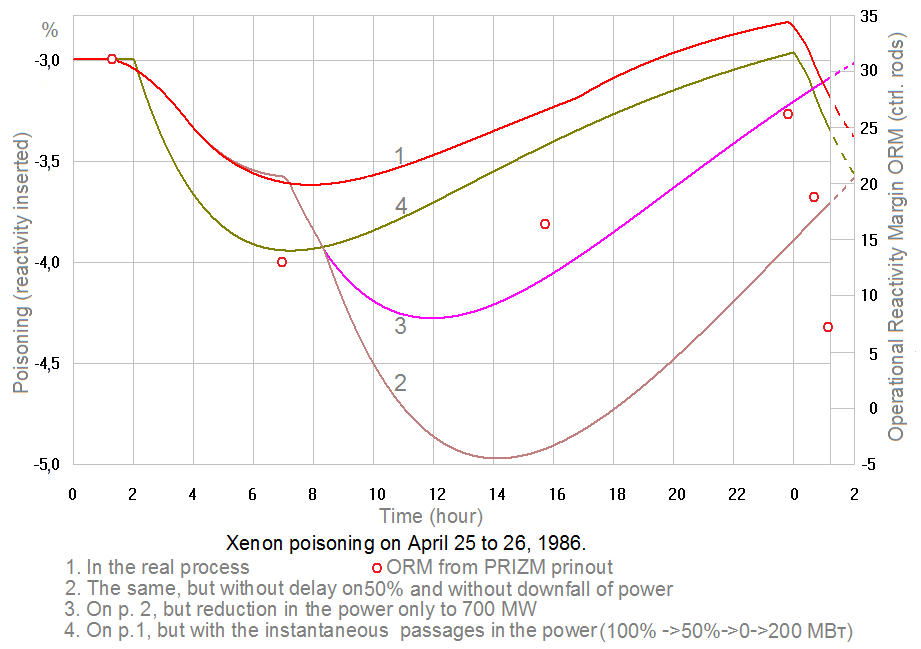The most significant contribution to a change in the operational reactivity margin (ORM) upon transfer of reactor from one level of power to another introduces undoubtedly the poisoning by xenon - 135. Therefore it not amazingly that are made the attempt to assign low values of ORM, obtained with the decrease of the power of the 4-th ChNPP power unit on April 25 to 26, 1986, to excessively deep poisoning by xenon - 135, allegedly arisen in the real transient process ([Y2], p. 308)([M2], p. 24)([M2], p. 88). It is implied (clear or implicitly) that this is caused by deviations in realizing of this transient process: large delay at the level of the 50% power (after a decrease from 100%), short-term downfall of power to zero during reduction below 700 MW, etc.
Meanwhile the reactor poisoning by xenon -135 can be described sufficiently precise for practical purposes, by ordinary differential equations, whose numerical solution is not a large problem for any transient process upon the power. Lower figure gives the results of such calculations. For the classical idealized cases of instantaneous transition from one stationary level of power to another the equations have the precise, analytical solution. These solutions are well known and widely are used as in the practice of the NPP operation ([Ę1], p. 341), and in the reactors designing ([E1], p. 36). 
Fig. gives (in the form points) also values of ORM calculated by “PRISMA” code during the operation on April 25 to 26. It is evident from the comparison of these data with the graph of poisoning (curve 1) that xenon poisoning not only process, which determined the decrease of ORM, although the basic one. Other processes, which accompany power change, also introduce the noticeable contribution. Together with the calculation of poisoning for the actually occurred process of the reactor power change, there is given the graph of poisoning for the idealized case of the instantaneous, spasmodic passages between the same levels of power (curve 4). It is evident that the extent of these passages in the time, decreases the real poisoning in comparison with the fact that it is obtained during the idealization of passages.
It is separately checked (in curves 1 and 4), that the presence or the absence of a short-term drop in the power to zero, with the retention of entire rest features of the diagram of power change, practically does not influence the graph of poisoning. And this is completely expected, the time being of the power of reactor in the state of downfall and getting out of it (5-15 min.) is nothing in comparison with the characteristic time of poisoning (8-9 hours). So, “self suppressing of reactor” ([E2], đ. 581), if it occurred, then it occurred not because of the “deep poisoning”, but as a result of other effects in the reactivity, which form positive feedback between the power and the reactivity.
In order to clear up how the 20-hour delay at the 50% level of power had influenced the depth of poisoning, the calculation of poisoning was carried out for reduction in the power (from 100% to 200 MW) with the retention of the same passages between levels 3100, 1600, 720 and 200 MW, as they were in reality, but with shortening of retention time at the power of 1600 MW up to the 3rd hours (it would be hardly possible technologically to make it less). Besides that the downfall of power to zero and going out of downfall during the 9-minute interval of time from 00:30 to 00:39 (according to said above) are substituted by smooth reduction in the power from 240 to 100 mW. The result of this calculation is presented (by curve 2) in the figure above. The same calculation is carried out for the hypothetical case of reduction in the power only up to the level 700 MW (curve 3). Insignificant difference in these curves from curve 1 to the moment of the beginning of further reduction in the power from level 50%, it explains by the fact that decrease of retention time at power 50% from 20 to 3 hours had forced to omit the passage (with the recovery) from the level 1600 MW to the level 1500 MW (occurred in the real process).
Thus, long delay at the intermediate level of power 50% not only did not increase the depth of transient poisoning by xenon -135, but considerably has decreased it. Moreover, this delay should have been previously planned, if they would be going (in spite of the program) to begin conducting “rundown” experiment not at the power of 700 MW, but at the power of 200 MW, otherwise they fell into the poison outage.
to sitemap
|


